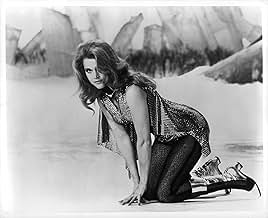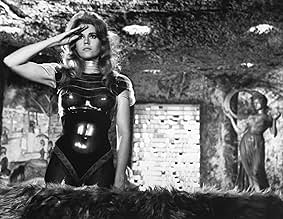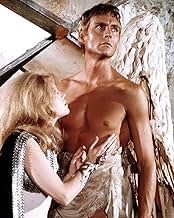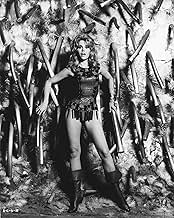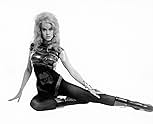CALIFICACIÓN DE IMDb
5.9/10
40 k
TU CALIFICACIÓN
Barbarella, un astronauta del siglo cuarenta y uno, se propone encontrar y detener al malvado científico Durand Durand, cuyo Rayo Positrónico amenaza con traer el mal de vuelta a la galaxia.Barbarella, un astronauta del siglo cuarenta y uno, se propone encontrar y detener al malvado científico Durand Durand, cuyo Rayo Positrónico amenaza con traer el mal de vuelta a la galaxia.Barbarella, un astronauta del siglo cuarenta y uno, se propone encontrar y detener al malvado científico Durand Durand, cuyo Rayo Positrónico amenaza con traer el mal de vuelta a la galaxia.
- Dirección
- Guionistas
- Elenco
- Premios
- 1 nominación en total
Véronique Vendell
- Captain Moon
- (as Veronique Vendell)
Franco Gulà
- The Suicide
- (escenas eliminadas)
- (as Franco Gula)
Honey Autumn
- Bald Handmaiden at Sogovian Court
- (sin créditos)
Silvana Bacci
- Girl in Sogo
- (sin créditos)
Opiniones destacadas
Take a kaleidoscope to your eye, let it dwell, at the night sky, after a while you just might see, colours conjured, so wild and free, imagination is the game, often wildly insane, a pinch of salt may be required, but this is elegance inspired.
It's as daft as it's delirious, and to some mildly nefarious, but Jane Fonda is a star, and this is an early car, that delivers all her talents, all the things that make her balance, with many tongues in many cheeks, it's most always, worth a peek.
A wonderfully wild ride through a universe long since forgotten, and seldom revisited, that indelibly reminds us of a a time when boundaries needed breaking, and often were.
It's as daft as it's delirious, and to some mildly nefarious, but Jane Fonda is a star, and this is an early car, that delivers all her talents, all the things that make her balance, with many tongues in many cheeks, it's most always, worth a peek.
A wonderfully wild ride through a universe long since forgotten, and seldom revisited, that indelibly reminds us of a a time when boundaries needed breaking, and often were.
I'm not sure if I liked this film or hated it!! It reminds me of "Danger:Diabolik", that flash trash movie also with John Phillip Law. It is bright and loud and trashy with a little soft porn thrown in for good measure. It does tend to hold your interest throughout, maybe because you can't wait to see what outrageous scene will assault your senses next. And oh, all that phallic symbolism! Roger Vadim certainly exploited Jane Fonda in this one and she would probably like to forget the whole thing....but you've got to admit she doesn't look too bad in that plastic see-through bustier. John Phillip Law, who is a handsome devil(oops, angel), plays the part of the blind angel, Pygar, without emotion or feeling....but he played every character he ever portrayed exactly the same way. He wasn't much of an actor but it works here. This film screams the 60's, so turn on, tune out, plug in your lava lamp and take a look at it. You'll love it or hate it but you are guaranteed to have fun with it. It's the epitome of pop art!
Just what were they on? "Barbarella" is one of those sixties films (the Beatles vehicle "Help!" is another) which, although it makes no explicit references to the decade's drug culture, nevertheless leaves the indelible impression that the director, the scriptwriter, the set designer, the costume designer, the cameramen and most of the cast were under the influence of mind-expanding drugs throughout the entire shooting period.
I first saw the film at university in the early eighties when a student film society organised a screening. Interest in it at that time may have been aroused by the release in 1980 of "Flash Gordon", another ultra-camp science fiction film which was undoubtedly influenced by it, and by the fact that one of the leading British pop groups of the era had called themselves Duran Duran in homage to their origins in a now-defunct Birmingham nightclub called Barbarella's.
The film is based on a French series of comic books, which I must admit I have never read. (Unlike, say, the "Asterix" or "Tintin" series, the Barbarella comics have never had much of a following in Britain). The action takes place in the 40th century. Barbarella, a beautiful young female astronaut, is ordered by the President of Earth to travel to the planet Tau Ceti to find a scientist named Durand Durand, from whom the band took their misspelled name. Durand is the inventor of a weapon known as the Positronic Ray, which the President fears may fall into the wrong hands.
The rest of the film is taken up with Barbarella's increasingly bizarre adventures on Tau Ceti. She goes ice-skiing across the planet's frozen surface, pulled along by an octopus-like creature, is menaced by flesh-eating dolls with razor-sharp teeth, seduces a blind angel (or "ornithanthrope"), meets the predatory lesbian Queen of a decadent city and survives an attempted execution by means of an "orgasmatron", a machine designed to kill by an excess of sexual pleasure. (Barbarella's capacity for sexual pleasure is so great that she blows its circuits). We are not, of course, meant to take any of this seriously; the whole thing is intended as a sort of tongue-in-cheek exercise in high camp surrealism, Salvador Dali meets Edna Everage. The surreal nature of the film is emphasised by the use of psychedelic lighting effects. (The opening song even includes the rhyme "Barbarella Psychedella").
Barbarella is played by Jane Fonda, who at the time was married to the director Roger Vadim, clearly a man with the knack of attracting beautiful women. (He had previously been married to Brigitte Bardot and had been the lover of Catherine Deneuve). I wonder if, when Fonda was taking her wedding vows, she realised that Vadim's interpretation of "for better or for worse" included casting his wife in eccentric films like this one. Her devotion to her wifely duties seems to have been at the expense of her career; she later revealed that her commitment to "Barbarella" meant having to turn down the leading roles in two more serious films, "Bonnie and Clyde" and "Rosemary's Baby". Moreover, many of the heroine's adventures seem to have been designed with the express purpose of showing off Fonda's figure in a series of provocative outfits, leaving her with a lasting "sex kitten" image. This was something she was never comfortable with, especially when she was trying to reinvent herself as a feminist and left-wing activist a few years later.
This is far from being Fonda's best film, yet she is about the only cast member who emerges with any credit from it, playing the heroine as a sort of wide-eyed innocent abroad. John Phillip Law, who plays the ornithanthrope Pygar, is so wooden that I wondered if he was under instructions to play his role with a deliberately deadpan lack of emotion. David Hemmings as the resistance leader Dildano shows us just why his career never really took off in the way it was expected to after his early breakthrough in "Blowup". (Hemmings's costume, looking like a pair of leather Y-fronts, is just as bizarre as anything worn by Fonda). Marcel Marceau shows that his talents as a mime did not extend to acting in spoken roles. Anita Pallenberg, better known for her relationships with several members of the Rolling Stones, was cast as the wicked Queen, but Vadim did not trust her to speak her own lines; the Queen speaks with the unmistakable contralto tones of Joan Greenwood.
"Barbarella" was a failure on its release, both at the box office and with the critics, yet despite the dodgy acting and the nonsensical plot it has since 1968 acquired the status of a cult movie. (Even back in my student days it was regarded as sort of historic artifact). Cults, whether religious or cinematic, can be baffling to everyone except ardent devotees, yet I must confess that I have a soft spot for this surreal relic of the hippie era. It is an ideal film to watch when returning from the pub late at night. Particularly if one is drunk. 6/10
I first saw the film at university in the early eighties when a student film society organised a screening. Interest in it at that time may have been aroused by the release in 1980 of "Flash Gordon", another ultra-camp science fiction film which was undoubtedly influenced by it, and by the fact that one of the leading British pop groups of the era had called themselves Duran Duran in homage to their origins in a now-defunct Birmingham nightclub called Barbarella's.
The film is based on a French series of comic books, which I must admit I have never read. (Unlike, say, the "Asterix" or "Tintin" series, the Barbarella comics have never had much of a following in Britain). The action takes place in the 40th century. Barbarella, a beautiful young female astronaut, is ordered by the President of Earth to travel to the planet Tau Ceti to find a scientist named Durand Durand, from whom the band took their misspelled name. Durand is the inventor of a weapon known as the Positronic Ray, which the President fears may fall into the wrong hands.
The rest of the film is taken up with Barbarella's increasingly bizarre adventures on Tau Ceti. She goes ice-skiing across the planet's frozen surface, pulled along by an octopus-like creature, is menaced by flesh-eating dolls with razor-sharp teeth, seduces a blind angel (or "ornithanthrope"), meets the predatory lesbian Queen of a decadent city and survives an attempted execution by means of an "orgasmatron", a machine designed to kill by an excess of sexual pleasure. (Barbarella's capacity for sexual pleasure is so great that she blows its circuits). We are not, of course, meant to take any of this seriously; the whole thing is intended as a sort of tongue-in-cheek exercise in high camp surrealism, Salvador Dali meets Edna Everage. The surreal nature of the film is emphasised by the use of psychedelic lighting effects. (The opening song even includes the rhyme "Barbarella Psychedella").
Barbarella is played by Jane Fonda, who at the time was married to the director Roger Vadim, clearly a man with the knack of attracting beautiful women. (He had previously been married to Brigitte Bardot and had been the lover of Catherine Deneuve). I wonder if, when Fonda was taking her wedding vows, she realised that Vadim's interpretation of "for better or for worse" included casting his wife in eccentric films like this one. Her devotion to her wifely duties seems to have been at the expense of her career; she later revealed that her commitment to "Barbarella" meant having to turn down the leading roles in two more serious films, "Bonnie and Clyde" and "Rosemary's Baby". Moreover, many of the heroine's adventures seem to have been designed with the express purpose of showing off Fonda's figure in a series of provocative outfits, leaving her with a lasting "sex kitten" image. This was something she was never comfortable with, especially when she was trying to reinvent herself as a feminist and left-wing activist a few years later.
This is far from being Fonda's best film, yet she is about the only cast member who emerges with any credit from it, playing the heroine as a sort of wide-eyed innocent abroad. John Phillip Law, who plays the ornithanthrope Pygar, is so wooden that I wondered if he was under instructions to play his role with a deliberately deadpan lack of emotion. David Hemmings as the resistance leader Dildano shows us just why his career never really took off in the way it was expected to after his early breakthrough in "Blowup". (Hemmings's costume, looking like a pair of leather Y-fronts, is just as bizarre as anything worn by Fonda). Marcel Marceau shows that his talents as a mime did not extend to acting in spoken roles. Anita Pallenberg, better known for her relationships with several members of the Rolling Stones, was cast as the wicked Queen, but Vadim did not trust her to speak her own lines; the Queen speaks with the unmistakable contralto tones of Joan Greenwood.
"Barbarella" was a failure on its release, both at the box office and with the critics, yet despite the dodgy acting and the nonsensical plot it has since 1968 acquired the status of a cult movie. (Even back in my student days it was regarded as sort of historic artifact). Cults, whether religious or cinematic, can be baffling to everyone except ardent devotees, yet I must confess that I have a soft spot for this surreal relic of the hippie era. It is an ideal film to watch when returning from the pub late at night. Particularly if one is drunk. 6/10
Really and truly, this could be the plot of one of the more "high-brow" types of porn. I watched this with a bunch of other girls for a class, and we could not stop laughing the entire time.
See Jane Fonda meet men from around the galaxy, and have sex with them! Dare your friends to count how many times she changes her costume!! Sparks deep philosophical discussion, like what exactly the writers were on when they wrote this. Great fun, not to be missed!
See Jane Fonda meet men from around the galaxy, and have sex with them! Dare your friends to count how many times she changes her costume!! Sparks deep philosophical discussion, like what exactly the writers were on when they wrote this. Great fun, not to be missed!
In the year 40,000, a stunningly attractive adventurer named Barbarella (Jane Fonda) is assigned by the President of the Republic of Earth (Claude Dauphin) to track down an evil scientist. This scientist has invented a weapon in an era of pacifism in this intergalactic society, and has disappeared into an area dubbed Tau Seti. Barbarella will have many interesting experiences, and encounter a rich variety of characters, such as winged man Pygar (John Phillip Law), a nasty but sultry villainess (Anita Pallenberg), and a sadistic Concierge (Milo O'Shea).
The opening striptease by Jane (with the opening credits moved around to help obscure her nudity) may play a pivotal part in why this is so beloved as a cult classic 50 years later. But in truth, this off the wall science fiction tale is plenty goofy, enough so that the movie does have a real sense of fun going for it. It amps up its sex appeal and its psychedelic qualities to the nth degree, and its production design (by Mario Garbuglia) and cinematography (by Claude Renoir) are first-rate. Along with amusing special effects, this results in a non-stop assortment of futuristic and exotic eye candy. Based on a best-seller by Jean-Claude Forest, the script (bearing contributions by EIGHT credited individuals) contains some endearingly literate but silly dialogue.
Jane is appealing, playing a character who is not all that heroic; she needs saving more than once, and often must rely on the help of others. Her wide-eyed innocence (and that of the likeable hunk Law) is contrasted by the lascivious qualities of the production and the delicious villainy of the characters played by Pallenberg and O'Shea. (Trivia note: a certain 80s rock band took its name from the name of O'Sheas' character.) Memorable contributions are also made by Marcel Marceau, David Hemmings (very funny as a comedy-relief revolutionary), and Ugo Tognazzi.
Complete with a catchy, groovy score and songs (by Charles Fox and Bob Crewe), and Roger Vadim (Janes' husband at the time) directs with great style.
Overall, quite engaging, although clearly not something to be taken seriously.
Seven out of 10.
The opening striptease by Jane (with the opening credits moved around to help obscure her nudity) may play a pivotal part in why this is so beloved as a cult classic 50 years later. But in truth, this off the wall science fiction tale is plenty goofy, enough so that the movie does have a real sense of fun going for it. It amps up its sex appeal and its psychedelic qualities to the nth degree, and its production design (by Mario Garbuglia) and cinematography (by Claude Renoir) are first-rate. Along with amusing special effects, this results in a non-stop assortment of futuristic and exotic eye candy. Based on a best-seller by Jean-Claude Forest, the script (bearing contributions by EIGHT credited individuals) contains some endearingly literate but silly dialogue.
Jane is appealing, playing a character who is not all that heroic; she needs saving more than once, and often must rely on the help of others. Her wide-eyed innocence (and that of the likeable hunk Law) is contrasted by the lascivious qualities of the production and the delicious villainy of the characters played by Pallenberg and O'Shea. (Trivia note: a certain 80s rock band took its name from the name of O'Sheas' character.) Memorable contributions are also made by Marcel Marceau, David Hemmings (very funny as a comedy-relief revolutionary), and Ugo Tognazzi.
Complete with a catchy, groovy score and songs (by Charles Fox and Bob Crewe), and Roger Vadim (Janes' husband at the time) directs with great style.
Overall, quite engaging, although clearly not something to be taken seriously.
Seven out of 10.
¿Sabías que…?
- TriviaThe scenes during the opening credits where Barbarella seems to float around her spaceship were filmed by having Jane Fonda lie on a huge piece of Plexiglas with a picture of the spaceship underneath her. It was filmed from above, creating the illusion that she is in zero gravity.
- ErroresIt is established that Barbarella needs a Tongue Box, a device attached to the bracelet she wears on her left wrist, to understand the spoken language of Sogo. Barbarella loses the bracelet after the Excessive Machine scene, but she still understands the Great Tyrant, Pygar, and the Sogoites speaking through the Tyrant's monitor.
- Citas
Barbarella: What's that screaming? A good many dramatic situations begin with screaming...
- Créditos curiososIn the opening credits, the letters in the words move around in an attempt to obscure Barbarella's nudity.
- Versiones alternativasBarbarella was released in the USA before the MPAA introduced the motion picture rating system on November 1, 1968. It was consequently released with a tag "Suggested For Mature Audiences". A re-release in 1977 (to cash in on the success of La guerra de las galaxias (1977)) was edited to obtain a "PG" rating and was called "Barbarella: Queen Of The Galaxy". The video version is of the original uncut version and not the "PG" version (despite the subtitle "Queen of the Galaxy" and the "PG" rating on the cover).
- ConexionesEdited into Duran Duran: Burning the Ground (1989)
Selecciones populares
Inicia sesión para calificar y agrega a la lista de videos para obtener recomendaciones personalizadas
- How long is Barbarella?Con tecnología de Alexa
Detalles
- Fecha de lanzamiento
- Países de origen
- Idiomas
- También se conoce como
- Barbarella: Queen of the Galaxy
- Locaciones de filmación
- Productoras
- Ver más créditos de la compañía en IMDbPro
Taquilla
- Presupuesto
- USD 9,000,000 (estimado)
- Total a nivel mundial
- USD 1,622
- Tiempo de ejecución
- 1h 38min(98 min)
- Color
- Relación de aspecto
- 2.35 : 1
Contribuir a esta página
Sugiere una edición o agrega el contenido que falta



